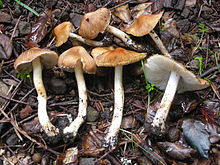Inocybe rimosa
| Inocybe rimosa | |
|---|---|

| |
| Scientific classification | |
| Kingdom: | Fungi
|
| Phylum: | |
| Class: | |
| Order: | |
| Family: | |
| Genus: | |
| Species: | Inocybe rimosa
|
| Binomial name | |
| I. rimosa (Bull.) P.Kumm.
| |
| Synonyms | |
Inocybe rimosa (formerly known as Inocybe fastigiata) is a poisonous mushroom native to Europe. Its toxic ingredient is muscarine, discovered during the 1930s.[1] Serious poisoning can result from consuming any quantity of the mushroom.[2]
German naturalist Jacob Christian Schäffer described this species in 1774. Lucien Quélet transferred it to the genus Inocybe in 1872.[3]
I. fastigiata has a brownish fibrous cap, and stalk that lacks a ring.
In Israel, I. fastigiata grows under Palestine oak (Quercus calliprinos) and pines, with mushrooms still appearing in periods of little or no rain as they are mycorrhizal.[4]
In Israel, it is confused with edible mushrooms of the genus Tricholoma, particularly Tricholoma terreum, and Suillus granulatus, all of which grow in similar habitat.[4]
References[]
- ^ Wilson, Donald (1947). "Poisoning by Inocybe fastigiata". Br Med J. 2 (4520): 297. doi:10.1136/bmj.2.4520.297. PMC 2055394. PMID 20257564.
- ^ Miller Jr., Orson K.; Miller, Hope H. (2006). North American Mushrooms: A Field Guide to Edible and Inedible Fungi. Guilford, CN: FalconGuide. p. 304. ISBN 978-0-7627-3109-1.
- ^ Quélet L. (1872). "Les Champignons du Jura et des Vosges". Mémoires de la Société d'Émulation de Montbéliard. II (in French). 5.
- ^ Jump up to: a b Lurie, Yael (2009). "Mushroom poisoning from species of genus Inocybe (fiber head". Clinical Toxicology. 47 (6): 562–65. doi:10.1080/15563650903008448. PMID 19566380. S2CID 205902282.
- Inocybe
- Poisonous fungi
- Fungi described in 1774
- Fungi of Europe
- Taxa named by Jean Baptiste François Pierre Bulliard